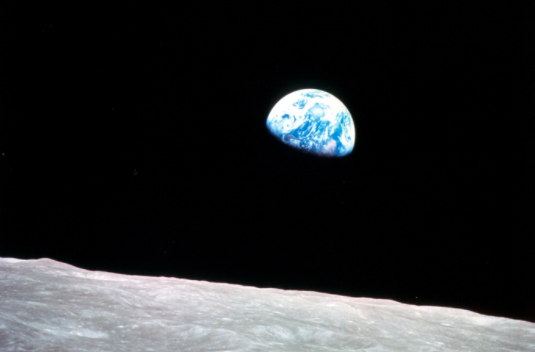Earthrise

Hover and click on this image to see earth rising over the moon horizon.
Earthrise was taken by astronaut William Anders during the Apollo 8 mission, the first crewed voyage to orbit the Moon.[4][5] Before Anders found a suitable 70 mm color film, mission commander Frank Borman took a black-and-white photograph of the scene, with the Earth's terminator touching the horizon. The land mass position and cloud patterns in this image are the same as those of the color photograph entitled Earthrise.[6]
The photograph was taken from lunar orbit on December 24, 1968, 15:40 UTC,[7][8] with a highly modified Hasselblad 500 EL with an electric drive. The camera had a simple sighting ring rather than the standard reflex viewfinder and was loaded with a 70 mm film magazine containing custom Ektachrome film developed by Kodak. Immediately prior, Anders had been photographing the lunar surface with a 250 mm lens; the lens was subsequently used for the Earthrise images.[9]
Anders: Oh my God! Look at that picture over there! There's the Earth coming up. Wow, that's pretty.
Borman: Hey, don't take that, it's not scheduled. (joking)[1]
Anders: (laughs) You got a color film, Jim?
Hand me that roll of color quick, would you...
Lovell: Oh man, that's great!
AS08-14-2383 (21713574299), from which Earthrise was cropped. The photo is displayed here in its original orientation as seen by the crew of Apollo 8. Lunar north is up.[10]
There were many images taken at that point. The mission audio tape establishes several photographs were taken, on Borman's orders, with the enthusiastic concurrence of Jim Lovell and Anders. Anders took the first color shot, then Lovell who notes the setting (1/250th of a second at f/11), followed by Anders with another very similar shot (AS08-14-2384).
A black and white reproduction of Borman's image appeared in his 1988 autobiography, captioned, "One of the most famous pictures in photographic history – taken after I grabbed the camera away from Bill Anders". Borman noted that this was the image "the Postal Service used on a stamp, and few photographs have been more frequently reproduced".[11]: 212 The photograph reproduced is not the same image as the Anders photograph; aside from the orientation, the cloud patterns differ. Borman later recanted this story and agreed that the black and white shot was also taken by Anders, based on evidence presented by transcript and a video produced by NASA Goddard Space Flight Center Scientific Visualization Studio employee, Ernie Wright.[9]
After Apollo 8's momentous return, NASA technicians – not able to wait for normal film processing – drove four hours from Houston to Corpus Christi Texas to the family-owned R & R Photo Studio & Color Labs (later known as R & R PhotoTechnics) which at that time was the first and only place in South Texas with color photo processing equipment. More importantly, R&R featured the rare 4-hour Ektachrome slide processing capability for the professional 220-size film used by the astronauts' Hasselblad, making R&R a convenient same-day trip for NASA's critical need.
There, the late owner Raul Rodriguez took the precious film which had travelled 500,000 miles (800,000 km) to the far side of the moon and back. He personally developed the slides and copied them to regular 220 negatives, which he then also had to develop. Then he exposed and printed the requested photos in quick 8" x 10" glossy size, one of which would eventually be known as Earthrise. Raul then returned the slides, negatives & photos to the appreciative NASA technicians to rush back to Houston.
For the Earthrise slides, then later the Earthrise negatives, Raul used a German-made Merz S2A dual-rocking-drum developer. To print the first Earthrise photo, he used an Auto-focus Chromega D4 enlarger that had modern dial-in color filters. It sat on a motorized-drive, lightproof, 11" wide, roll-paper carrier. The images came to life via Raul's then state-of-the-art, self-replenishing, mylar-leader, continuous-feed roll-photo paper processor produced by the Nord photo company then based in Minneapolis, Minnesota.
The stamp issue reproduces the cloud, color, and crater patterns of the Anders picture. Anders is described by Borman as holding "a masters degree in nuclear engineering"; Anders was thus tasked as "the scientific crew member ... also performing the photography duties that would be so important to the Apollo crew who actually landed on the Moon".[11]: 193
On the 50th anniversary of the Apollo 8 mission in 2018, Anders stated: "It really undercut my religious beliefs. The idea that things rotate around the pope and up there is a big supercomputer wondering whether Billy was a good boy yesterday? It doesn't make any sense. I became a big buddy of [atheist scientist] Richard Dawkins."[12]